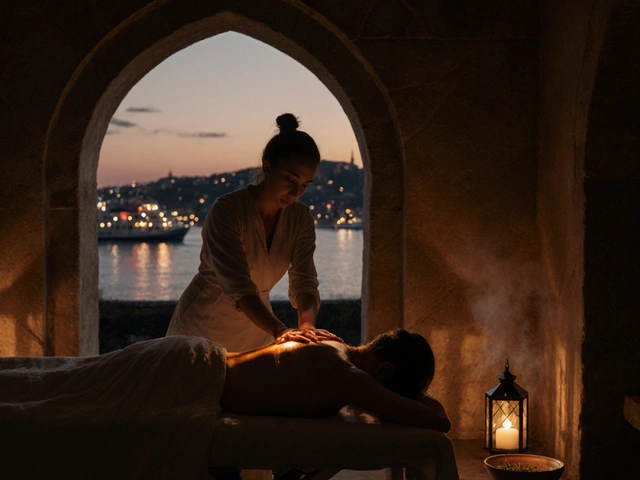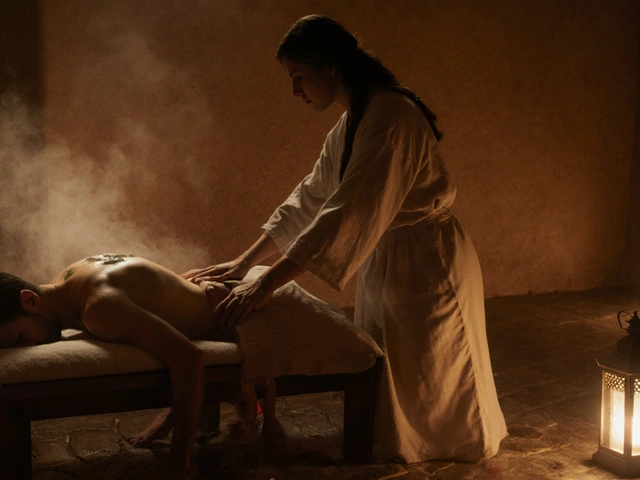You know that feeling when your shoulders are tight, your mind won’t shut off, and even deep breathing feels like too much work? You’ve tried yoga, but it didn’t stick. Or maybe you got a massage and felt amazing for a day-then it was back to square one. What if the real answer isn’t choosing between yoga or massage, but combining them?
Why Body Massage and Yoga Work Better Together
Yoga stretches your muscles, opens your joints, and calms your nervous system. Body massage melts away deep tension, releases fascial restrictions, and tells your brain it’s safe to relax. Alone, each helps. Together? They create a cycle of recovery that keeps going long after your session ends.
Think of your body like a tangled headphone cord. Yoga is the careful unraveling-slow, intentional, with patience. Massage is the warm water that softens the knots so they don’t snap back. Do one without the other, and the knots come back faster. Do both, and your body starts remembering what ease feels like.
Studies from the Journal of Alternative and Complementary Medicine show that people who combine regular massage with yoga report 40% more improvement in chronic pain and stress levels than those who do just one. That’s not magic. It’s biology.
What Happens When Massage Meets Yoga
After a deep tissue massage, your muscles are more pliable. Your nervous system is quieter. That’s the perfect window for yoga. You can sink deeper into poses without resistance. Your hamstrings, which were stubborn for months, suddenly bend. Your hips, locked tight from sitting all day, open with less effort.
And it works the other way too. When you practice yoga regularly, your body becomes more aware of tension. You notice when your jaw clenches, when your breath gets shallow, when your lower back tightens. That awareness means when you get a massage, you can tell the therapist exactly where to focus. No more guessing. No more wasted time.
One client, a 52-year-old teacher who’d been dealing with lower back pain for years, told me: “I did yoga for six months and felt nothing change. Then I added weekly massage. Three weeks later, I could bend down to tie my shoes without wincing. It wasn’t the yoga. It wasn’t the massage. It was both.”
Types of Massage That Pair Best With Yoga
Not all massages are created equal when paired with yoga. Here’s what works:
- Swedish Massage - Gentle, flowing strokes. Perfect if you’re new to massage or just want to relax before a yoga session. Increases circulation, eases mental stress.
- Myofascial Release - Targets the connective tissue wrapping your muscles. Ideal if you’re stiff, especially in the back, hips, or shoulders. This is the go-to for yogis with chronic tightness.
- Deep Tissue Massage - For those who’ve been practicing yoga for a while but still hit walls. Targets deeper layers of muscle. Best done 1-2 days before a yoga session, not right after.
- Thai Massage - A hybrid of yoga and massage. The therapist guides you through stretches while applying pressure. Feels like assisted yoga with hands-on support. Great if you struggle with flexibility.
Avoid hot stone or aromatherapy-only sessions if your goal is mobility. They’re relaxing, but they don’t fix the structural tension that limits your yoga progress.
How to Build Your Own Massage + Yoga Routine
You don’t need to do this perfectly. Just consistently.
- Start with massage once every 2 weeks - Even 60 minutes helps. Pick a therapist who understands movement and anatomy, not just “relaxation.”
- Do yoga 3-4 times a week - Focus on gentle flows: Hatha, Yin, or Restorative. Skip power yoga if you’re sore. Let your body heal.
- Time it right - Get a massage on a rest day, not right before yoga. Wait at least 24 hours after a deep session before stretching hard.
- Listen to your body - If you’re bruised or sore after a massage, scale back yoga intensity. If your hips feel looser after yoga, schedule your next massage in 10 days.
After 6 weeks, you’ll notice things you didn’t even know were broken: your sleep improves, you stop clenching your fists, you breathe deeper without thinking. That’s holistic wellness-not a trend, not a spa gimmick. That’s your body finally catching up to your intentions.

What to Expect in a Combined Session
Some wellness centers now offer “Yoga + Massage” packages. Here’s what a typical session looks like:
- First 15 minutes - You lie on a mat while the therapist checks in. Where are you tight? What do you want to feel after this?
- Next 45 minutes - You get a customized massage, focused on your problem areas.
- Final 20 minutes - You move into gentle yoga poses, guided by the therapist. They adjust your alignment, help you deepen stretches safely.
No candles, no chanting. Just quiet, focused work. You leave feeling like you’ve been reset-not just relaxed.
Cost and Where to Find It
Most standalone massages run $70-$120 for 60 minutes. Yoga classes? $15-$30 per session. A combined session usually costs $100-$160 for 90-120 minutes. It’s more expensive, but you’re getting double the benefit in half the time.
Look for studios that specialize in therapeutic yoga or sports recovery. Ask: “Do you offer massage and yoga in the same visit?” If they say no, ask for a referral. Many yoga teachers work with licensed massage therapists. You can book both separately but schedule them back-to-back.
In cities like New York, Portland, or Austin, you’ll find dedicated wellness centers that bundle the two. In smaller towns, check out physical therapy clinics that offer yoga as part of rehab-they often include massage too.
When Not to Combine Them
There are times when you should skip the combo:
- If you have an acute injury (sprained ankle, recent strain) - Wait until inflammation drops.
- If you’re feeling sick - Massage can overstimulate your immune system when you’re run down.
- If you’re emotionally overwhelmed - Sometimes you just need quiet. Don’t force it.
Listen to your body. If you feel shaky or dizzy after a massage, rest. Don’t jump into downward dog. If you’re sore after yoga, skip the deep tissue. Let your body recover.

Massage vs. Yoga: Which Does What?
| Aspect | Body Massage | Yoga |
|---|---|---|
| Relieves Muscle Tension | Immediate, deep release | Gradual, through movement |
| Improves Flexibility | Indirect (muscles relax so stretching becomes easier) | Direct (poses stretch and lengthen tissue) |
| Reduces Stress Hormones | Within minutes (cortisol drops 30% after 60 min) | Over time (consistent practice lowers baseline stress) |
| Builds Body Awareness | Passive (you feel it, but don’t control it) | Active (you learn to sense and adjust your posture) |
| Long-Term Maintenance | Requires ongoing sessions | Builds self-sufficiency |
Neither is better. They’re different tools. Massage is the reset button. Yoga is the daily tune-up.
Frequently Asked Questions
Can I do yoga after a deep tissue massage?
Yes-but keep it gentle. Wait at least 24 hours after a deep tissue session before doing intense yoga. Your muscles are still recovering. Stick to restorative poses, breathing exercises, or light stretching. Pushing too hard can cause micro-tears or bruising.
How often should I do massage and yoga together?
Start with one massage every two weeks and yoga 3-4 times a week. After 4-6 weeks, you can reduce massage to once a month if you’re feeling balanced. The goal isn’t to depend on massage-it’s to use it to support your yoga practice so you need less of it over time.
Is Thai massage the same as yoga?
No-but it’s the closest thing. Thai massage uses yoga-like stretches, but you’re passive. The therapist moves you. In yoga, you’re active. Thai massage is great for beginners or people who can’t move deeply on their own. Yoga builds strength and awareness. They complement each other.
Will this help with chronic pain?
Yes, especially if your pain comes from muscle imbalances or tension patterns. Many people with lower back pain, neck stiffness, or sciatica see big improvements when they combine regular massage with consistent yoga. It doesn’t cure structural issues like herniated discs, but it removes the tension that makes pain worse.
Do I need special gear or equipment?
No. For yoga, a non-slip mat is enough. For massage, just show up. Wear comfortable clothes you can move in. No oils, no props, no fancy gear needed. The real equipment is your willingness to show up and listen to your body.
Ready to Feel the Difference?
You don’t need to fix everything at once. Start small. Book one massage. Do yoga three times this week. See how your body responds. Notice if you sleep better. If you breathe deeper. If you stop holding your breath when you’re stressed.
This isn’t about becoming a yogi or a massage junkie. It’s about giving your body the care it’s been asking for-quietly, consistently, without drama. Massage and yoga together? That’s not a trend. That’s how you rebuild your resilience, one breath, one touch, at a time.





